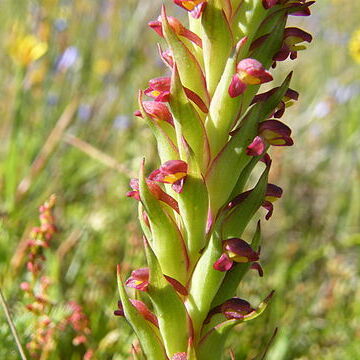Terrestrial herb, geophyte, 0.3-0.5 m high. Leaves many, cauline, largest near base, linear-lanceolate. Inflorescence cylindrical, dense 20-120 mm long; bracts overtopping the flowers. Flowers many, green, sepals tinted maroon. Sepals: median sepal shallowly galeate, broadly oblong, obtuse to acute, 3-4 mm long; spur shallowly triangular, pendent, 3.0-4.5 mm long; lateral sepals patent, oblong, acute, 2.5-3.5 mm long. Petals erect, partially included in galea, obtriangulate, acute, 2.0-2.5 mm long. Lip pendent, narrowly oblong to oblanceolate, 2.0-2.5 mm long. Anther pendent, rostellum with large notch. Flowering time Sept.-Nov.
Leaves 6–10 in a loose rosette, narrowly lanceolate, 30–150 × 15 mm, tapered, light green, channelled, reducing in size up stem. Flower stem 200–400 mm tall, thick, fleshy; flowers and bracts forming a cylindrical spike to 200 mm long. Floral bracts closely overlapping, 20–30 mm long. Flowers c. 5 × 5 mm, yellowish with red suffusions, sepals and petals tipped with red, labellum yellow. Dorsal sepal hooded, with a pendent spur. Lateral sepals divergent or recurved. Petals obliquely erect, margins enclosed by dorsal sepal. Labellum protruding like a tongue, oblong, c. 3.5 × 1.5 mm, decurved.
Slender or robust, tuberous geophyte to 30 cm. Leaves linear-lanceolate. Flowers many in a dense raceme, green with sepals tinted maroon, spur pendent, 3-4.5 mm long, lateral sepals 2.5-3.5 mm long.

